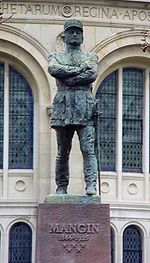Charles Mangin - Picture
More about World War 1

|
|
Charles Mangin
Nickname: "The Butcher"
Place of birth: Sarrebourg, Moselle
Place of death: Paris
Allegiance: France
Years of service: 1889-1925
Rank: General
Commands held: Third Army,
Sixth Army,
Tenth Army
Battles/wars: World War I
*Battle of Verdun
*Battle of the Aisne
*Second Battle of the Marne
Charles Emmanuel Marie Mangin (6 July 1866, Sarrebourg, Moselle - 12 May 1925, Paris) was a French general during World War I.
Career
A graduate of Saint-Cyr, Mangin served in Sudan (under Jean-Baptiste Marchand) and in French North Africa. In 1910 he published La force noire,where he called for the use of French Colonial Forces in the event of a European war. During the war he rose from divisional command to that of the 10th Army for the Second Battle of the Marne commanding both French and American troops. Nicknamed "the Butcher" for his espousal of la guerre x outrance and his faith in the suitability of North African troops for the attack, there was no doubt in the French Army that Mangin was personally fearless.
During that war, he had notable victories at Charleroi and then at Verdun, but his reputation suffered following the disastrous Nivelle Offensive, (16 April-9 May 1917). This was due partly to the fact that Mangin was one of the few high-ranking French officials who supported Nivelle's strategy.
Mangin's Sixth Army bore the brunt of the main attack during the Second Battle of the Aisne, the main component of Robert Nivelle's costly assault. After the failed operation was abandoned, both Mangin and Nivelle were removed from effective command. However, following Ferdinand Foch's promotion to Allied Supreme Commander (over Philippe Pétain), Mangin was recalled upon the orders of Prime Minister Clemenceau and given command initially of a corps and then of the French Tenth Army on the Western Front.

Picture - Statue of Charles Mangin in Paris, France
Although he was despised by some of his troops (who gave him the nickname "The Butcher"), Mangin's 10th Army was responsible for the crucial Allied counter-attack at the Second Battle of the Marne. It was this that largely promoted his military reputation. Mangin also became known for the observation: "Quoi qu'on fasse, on perd beaucoup de monde." ("Whatever you do," (i.e. attack or defend) "you lose a lot of men.").
In the closing months of the war, he served as part of General Castelnau's Army Group East, advancing towards Metz. After the Allied victory, Mangin's 10th Army was sent to occupy the Rhineland. There, Mangin became the focus of controversy due to his attempts to foster the establishment of a pro-French Rhenish Republic with the aim of separating it from Germany and thus denying Germany the West bank of the Rhine. Mangin became a member of the Supreme War Council and inspector general of French colonial troops. He fell seriously ill at his Paris home on the 9 March 1925, suffering from incredible pain. He became incoherent and partly paralysed. On the 10th he was diagnosed as suffering from appendicitis and as having suffered a stroke, though the rumour had it he may have been poisoned. He died at 9am two days later, 12 March. His remains were interred in Les Invalides in 1932, and a statue erected in his honour in 1928.
The statue of Mangin was destroyed in 1940 after the armistice. During his tour of Paris, Adolf Hitler visited Napoleon's tomb and the statue, being a reminder of Mangin's machinations in the Rhineland, was one of two he ordered dynamited. (The other was of Edith Cavell.) In 1957 a new statue was erected on the avenue de Breteuil.
Decorations
Légion d'honneur
Knight (30 December 1891)
Officer (1 October 1899)
Commander (13 September 1912)
Grand Officer (2 November 1916)
Grand Cross (6 July1919)
Médaille militaire (12 May 1925)
Croix de guerre 1914-1918
Médaille Interalliée de la Victoire
Médaille Commémorative de la Grande Guerre
Médaille Coloniale with "Sénégal et Soudan" clasp
Grand Officer of the Order of Saints Maurice and Lazarus (Italy)
Distinguished Service Medal (US)
Companion of the Order of the Bath (UK)
His Publications
La force noire, Hachette, Paris, 1910 (in this book Mangin predicted the quick and massive use of colonial troops, his so-called "Black Force", in the event of a war in Europe)
La Mission des troupes noires. Compte-rendu fait devant le comité de l'Afrique franx§aise, Comité de l'Afrique franx§aise, 1911, 44 p.
Comment finit la guerre, Plon-Nourrit, Paris, 1920, 330 p.
Des Hommes et des faits. I. Hoche. Marceau. Napoléon. Gallieni. La Marne. Laon. La Victoire. Le Chef. La Discipline. Le Problx¨me des races. Paul Adam : A la jeunesse. Réponse x M. P. Painlevé, Plon-Nourrit, 1923, 275 p.
Autour du continent latin avec le "Jules-Michelet", J. Dumoulin, Paris, 1923, 381 p.
Regards sur la France d'Afrique, Plon-Nourrit, Paris, 1924, 315 p.
Lettres du Soudan, Les x‰ditions des portiques, Paris, 1930, 253 p.
Un Régiment lorrain. Le 7-9. Verdun. La Somme, Floch, Mayenne ; Payot, Paris, 1935, 254 p.
Souvenirs d'Afrique : Lettres et carnets de route, Denox«l et Steele, Paris, 1936, 267 p.
Les Chasseurs dans la bataille de France. 47 division (juillet-novembre 1918), Floch, Mayenne ; Payot, Paris, 1935, 212 p.
Histoire de la nation franx§aise (publ. sous la direction de Gabriel Hanotaux), 8, Histoire militaire et navale, 2 partie, De la Constituante au Directoire, Plon, Paris, 1937
Lettres de guerre : [x sa femme] 1914-1918, Fayard, 1950, 323 p.
Portions of this article were translated from the French Wikipedia article fr:Charles Mangin.
Mangin, Louis-Eugx¨ne. Le Général Mangin. 1990.
Evans, M. M. Battles of World War I. Select Editions. 2004. ISBN 1-84193-226-4.
Heywood, Chester D. "Negro combat troops in the world war". 1928.
More aircraft.
Source: WikiPedia